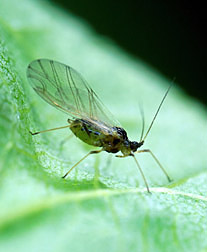|
Contents
Aphid Pest Gets “Egged”

An alate (winged) green peach aphid, Myzus persicae.
(K9602-1)
|
You might not expect so from its name, but the green peach aphid, Myzus persicae, attacks potatoes. The pest can add insult to injury by siphoning juices from plants and infecting them with viruses that cause $100 million annually in U.S. potato losses.
But getting a fix on where and when the aphid is likely to transmit pathogens such as the potato leafroll virus (PLRV) is difficult, mainly because the dash-sized pest is hard to capture. Enter Thomas R. Unruh, an entomologist with ARS’s Yakima Agricultural Research Laboratory in Wapato, Washington, who’s devised a way to track the aphid using egg proteins, mesh screens, and an antibody-based test.
“Some studies suggest that aphids enter the fields carrying potato viruses after being wind-blown for miles, while others suggest that they move into fields from nearby weedy reservoirs of the virus,” says Unruh. “Scientists have tried to tease out these alternatives but have had limited success because there was no reliable way of marking and recapturing the aphids.”
Unruh’s approach involves mixing egg-white proteins and water to form a solution that can be sprayed onto host plants like potato or weeds like nightshade. Aphids acquire egg proteins while crawling over treated areas. Tracking them necessitates Unruh’s second innovation: wide-mesh screens secured below a teepee-like scaffold, which can easily be deployed in or near potato fields.
A special adhesive secures captured aphids so they can be returned to the lab and analyzed with an immunological assay. If egg proteins are present, they’ll bind to complementary antibodies and generate a telltale signal.
In field trials near Wapato, more than 50 percent of green peach aphids that had contacted treated potato plants tested positive for egg-protein markers. “We’re now testing movement away from patches of nightshade and using a DNA-based procedure to detect whether the nightshade and marked aphids have PLRV,” says Unruh.
Improved insecticide timing and new IPM approaches are among expected benefits.—By Jan Suszkiw, Agricultural Research Service Information Staff.
This research is part of Crop Protection and Quarantine, an ARS national program (#304) described on the World Wide Web at www.nps.ars.usda.gov.
Thomas R. Unruh is with the USDA-ARS Yakima Agricultural Research Laboratory, 5230 Konnowac Pass Rd., Wapato, WA 98951; phone (509) 454-6563, fax (509) 454-5646.
"Aphid Pest Gets “Egged”" was published in the May/June 2008 issue of Agricultural Research magazine.
[Top]
|